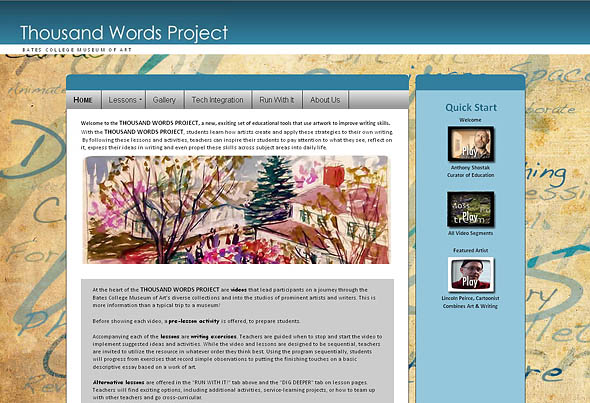Museum's language-arts initiative launches educational website, video
For more than a decade, the Thousand Words Project has been the flagship educational outreach program of the Bates College Museum of Art.
Now the museum has launched an educational website for the program, complete with instructional video.
Designed for middle-school language arts teachers and students, but adaptable to all grades, the TWP uses artworks from the College Museum of Art collection to explore the creative processes in writing and the making of visual art. The new website centers on specifics of this process, including research, editing and revising, ideas, symbols and metaphors, lines and more.
“Creativity is at the heart of the TWP,” says Anthony Shostak, curator of education for the museum and originator of the TWP. “By giving students a long look into the creative process, we show them clear connections between communication and their studies across the disciplines, from art to history, to science and math — all while they are improving their writing and speaking skills.”
Lessons, along with ideas for going deeper, accompany the video, affording a valuable curriculum resource for teachers and homeschooling parents. By focusing on process, students gain skills through direct practice. Sequential sets of exercises build upon each other to allow students to write complete essays, enabling them to see the creative process through to fruition.
The development of the curriculum resources and website was made possible by generous support from private foundations. “Teachers who saw the video at a stakeholders’ meeting last fall were simply ecstatic over the quality and potential,” says Shostak. “The newest evolution of our program caught the attention of educators statewide, and we hadn’t even formally launched the video yet.”
The video was produced by Leighton Images of Durham. “This was a great project,” says co-producer Geoffrey Leighton. “Not only did we get to explore how writers and artists work, but we were able to use our skills as filmmakers and animators to convey the intangibles of the creative process.”
Adds co-producer Anita Clearfield, “What was exciting to me was the development of the online curriculum that supports the video. I loved knowing that we are giving teachers tools to really make this video work in the classroom.”
“The TWP has traditionally been offered as a museum tour or school visit, with me as the presenter,” says Shostak. “Now, using interviews with artists, animations and links to computer tools, the website is a vastly more powerful resource available to teachers right in the classroom.”
To learn more about the TWP, visit the website or contact Shostak by e-mail or at 207-786-8302.



